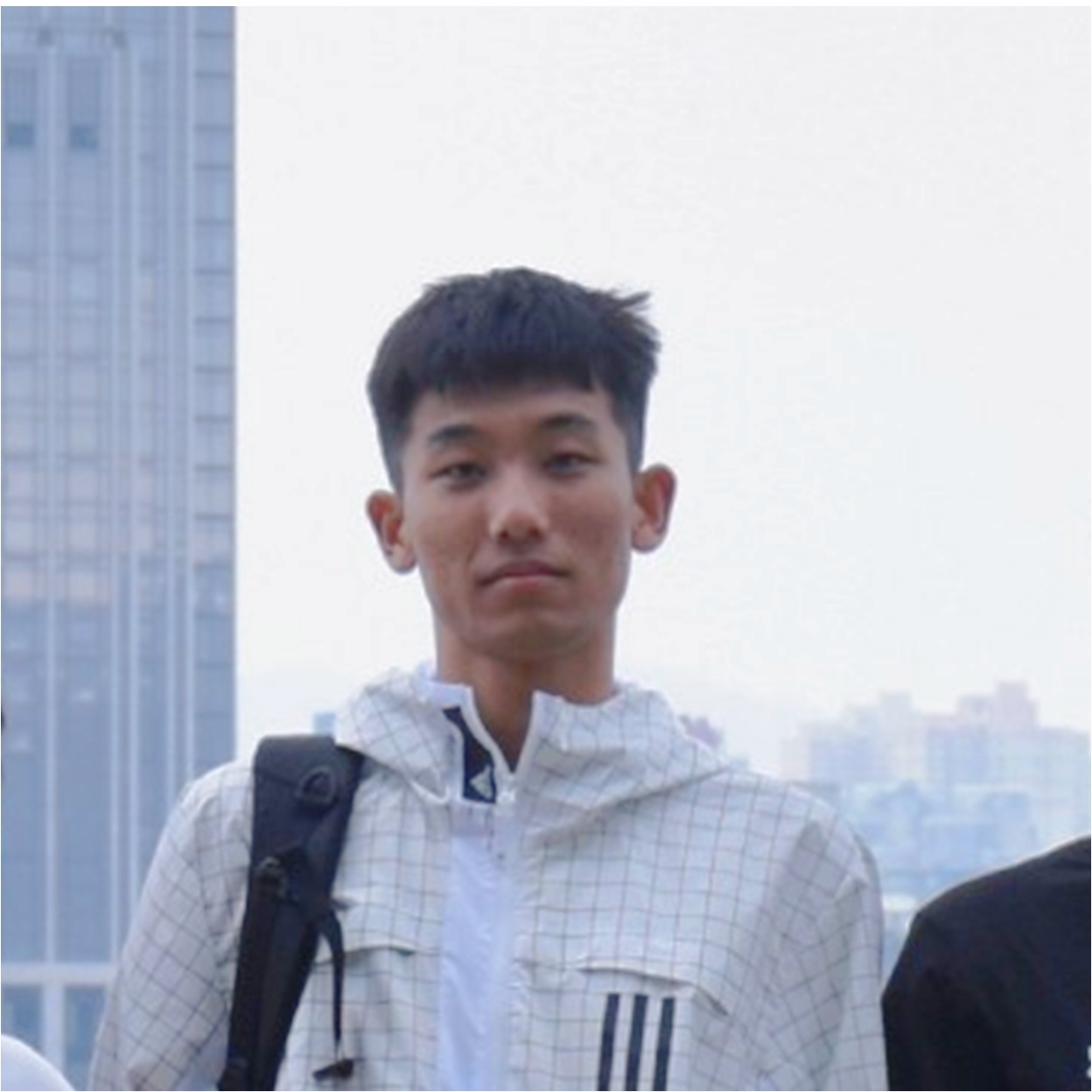Renyuan Liu
+86 14784206312 | rliu@e.gzhu.edu.cn
Education
Guangzhou University
Sept. 2022 - Jun. 2026 (Expected)
B.Eng. in Computer Science (Information Security); GPA: 90.13/100.00; Ranking: Top 10%
Curriculum: Machine Learning 100*, Data Structure and Algorithm Laboratory 99*, Operating System 98* (Course Project 95*), Programming Practice 98*, Data Structure and Algorithm 97*, Programming Laboratory I 95*, Computer Network (Course Project 95*), Principles of Computer Composition, Higher Mathematics, Discrete Mathematics, Linear Algebra, Probability and Mathematical Statistics (*: rank 1st in all students of the course).The University of Hong Kong/University of Macau (Summer Camp)
Nov. 2023
GPA: 97.50/100.00 (Interdisciplinary Programme)
Honor: Commendation Letter for Outstanding Performance in the Winning Team
Publications
R. Liu and Q. Fu, Attention-Driven LPLC2 Neural Ensemble Model for Multi-Target Looming Detection and Localization. The 2025 International Joint Conference on Neural Networks (CCF-C, acceptance rate ≈ 38%).
G. Gao*, R. Liu, M. Wang and Q. Fu*, A Computationally Efficient Neuronal Model for Collision Detection With Contrast Polarity-Specific Feed-Forward Inhibition. Biomimetics, vol. 9, no. 11, p. 650, 2024 (JCR Q1, IF = 3.4).
C. Fang*, H. Zhou, R. Liu, and Q. Fu*, A neuromorphic binocular framework fusing directional and depth motion cues towards precise collision prediction. Accepted at Neurocomputing (JCR Q1, IF = 6.5).
H. Zhou, C. Fang, R. Liu, and Q. Fu, A Bio-Plausible Neural Network Integrating Motion and Disparity Pathways for Looming Perception. Accepted at Acta Electronica Sinica (CCF-A, in Chinese).
J. Huang*, Z. Qin, M. Wang, R Liu, and Q. Fu*, A Biomimetic Collision Detection Visual Neural Model Coordinating Self-and-Lateral Inhibitions. The 14th International Conference on Biomimetic and Biohybrid Systems (Living Machines 2025).
Manuscripts Under Review
- M. Wang*, R. Liu*, W. He, and Q. Fu, A Neuronal Assembly Model with Elevated Time Derivative Boosts Loom-Selectivity. Submitted to PeerJ Computer Science (JCR Q1).
Honors and Awards
Provincial First Prize, Chinese Collegiate Computing Competition (4C)
May 2025Honorable Mention, Mathematical Contest in Modeling (MCM)
Jan. 2025National First Prize (Top 5%), Asia and Pacific Mathematical Contest in Modeling (APMCM)
Nov. 2024Provincial First Prize & Innovation Silver Award (Top 2 out of 1,167 Teams),
“Greater Bay Area Cup” Guangdong-Hong Kong-Macao Financial Mathematics Modeling Competition
Nov. 2024The Third-Class Scholarship (Top 12%), Guangzhou University
Nov. 2024The First-Class Scholarship (Top 5%), Guangzhou University
Nov. 2023
Research Experience
Computational Autonomous Learning Systems Lab Advisor: Prof. Pengcheng Liu
Department of Computer Science, University of York, York, UK (On-Site)
- Bio-inspired models and biologically-plausible mechanisms for life-long learning machine intelligence, robotics and autonomous systems
Jun. 2025 – Present- Working with the Franka Emika Panda and TurtleBot 3, I study biologically inspired mechanisms to enable life-long learning in robotics, focusing on perception, motion, and adaptability.
Machine Life and Intelligence Research Centre Advisor: Prof. Qinbing Fu
School of Mathematics and Information Science, Guangzhou University, Guangzhou, China
- Real-time Visual Processing Systems Development of Micro-Mobile Robot
Mar. 2023- Present- Reading and giving reports of research articles during research seminars on a weekly basis.
- Deployed visual neural network models inspired by insect neurons onto the STM32-based micro-robot Colias, achieving real-time collision perception and avoidance. Optimized model memory usage to fit within the 62 KByte SRAM capacity of Colias; developed and refined algorithms to enable real-time execution under extreme computational constraints (processing time < 33 ms on the STM32F427 chip); performed debugging, tuning, and conducted both offline and online experiments.
- A poster illustrating the fly-inspired closed-loop visual-perception and motion-control system for the micro robot Colias is accepted at the 26th Towards Autonomous Robotic Systems (TAROS 2025).
- Selected code can be accessed below:
Fly Visuomotor-Inspired Attention-LPLC2 Model (independently, 2k lines of code in C);
Locust Vision-Inspired Optimized-LGMD Model (independently, 1k lines of code in C).
- Attention-Driven LPLC2 Neural Ensemble Model for Multi-Target Looming Detection and Localization, paper accepted at IJCNN 2025, first author.
Jul. 2024 - Nov. 2024- Conducted full-cycle research on modeling the lobula plate/lobula columnar type 2 (LPLC2) neural ensemble in the fruit fly Drosophila, known for its ultra-selectivity to looming stimuli.
- Developed the multi-attention LPLC2 (mLPLC2) neural network model inspired by the visual system of the fly by leveraging a bottom-up attention mechanism driven by motion-sensitive neural pathways (independently, 3k lines of code in C/C++).
- A Computationally Efficient Neuronal Model for Collision Detection with Contrast Polarity-Specific Feed-Forward Inhibition, article published at Biomimetics, second author.
Mar. 2024 - Jul. 2024- Participated in the entire research on modeling the optimized locust lobula giant movement detector neuron with detailed feed-forward inhibition (oLGMD) to enhance processing speed and the robustness towards translating movement.
- Implemented oLGMD model into the embedded system of Colias, and conducted closed-loop arena comparative experiments to evaluate performance of oLGMD, achieving the highest success ratio of collision avoidance at 97.51% while nearly halving the processing time compared with previous LGMD models; conducted all online experiments of this paper, analyzing the results using real-world data collected by the Colias robot; designed criteria to assess time efficiency and collision selectivity.
- Led the initial writing of the introduction and experimentation sections; participated in revising the submitted paper.
- Bio-Inspired LGMD Collision Detection Model Leveraging Optical Flow and Learning-Based Optimization, Provincial Key College Students’ Innovative Entrepreneurial Training Plan Program.
Mar. 2023 - Present- Developed neuromorphic binocular models for collision prediction which combines directional and depth motion cues; optimized directional-selective neuron parameters using a genetic algorithm; collected a stereo RGB-D dataset capturing diverse indoor-outdoor collision scenarios to support model training and evaluation; conducted online robotic experiments with the TurtleBot 4 robot.
- Designed detailed figures illustrating the models and experiments; drafted manuscript introductions, and contributed to manuscript revisions.
Skills / Learning is the one of the happniest thing in the world
- Language: IELTS 6.5 (R8.0, L6.5, W6.0, S5.5), CET-6 564 (242/248.5 in the reading section)
- Programming Skills: C/C++, Python, Matlab
- Others: ROS (Noetic), LaTeX, Keil, Webots, Linux, Git, Markdown, MS Office/Visio, Adobe Photoshop/Premiere Pro
Hobbies: Movie, Music, Photography, Basketball, Jogging, Badminton, Hiking, Cooking.
